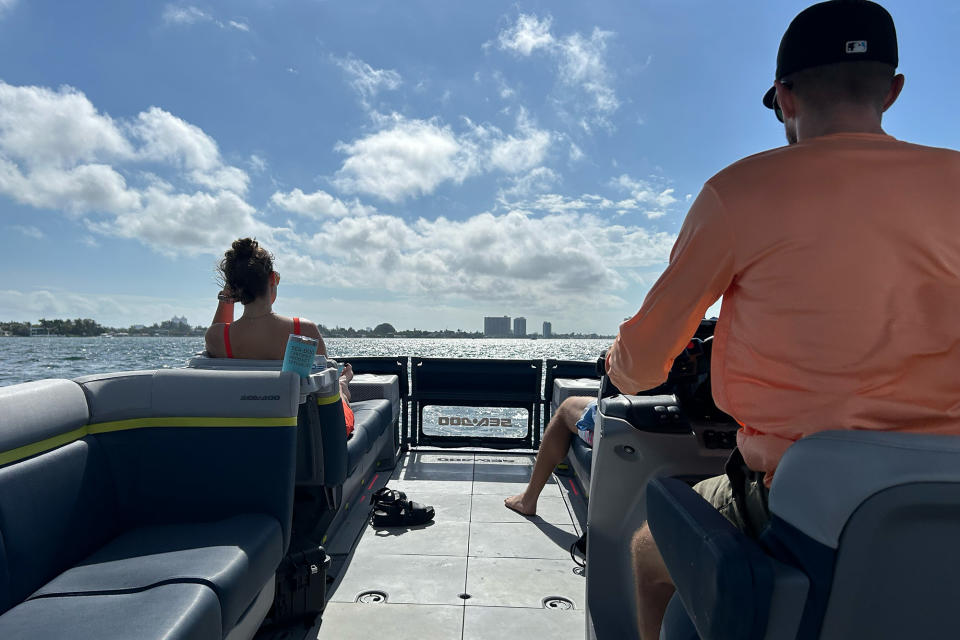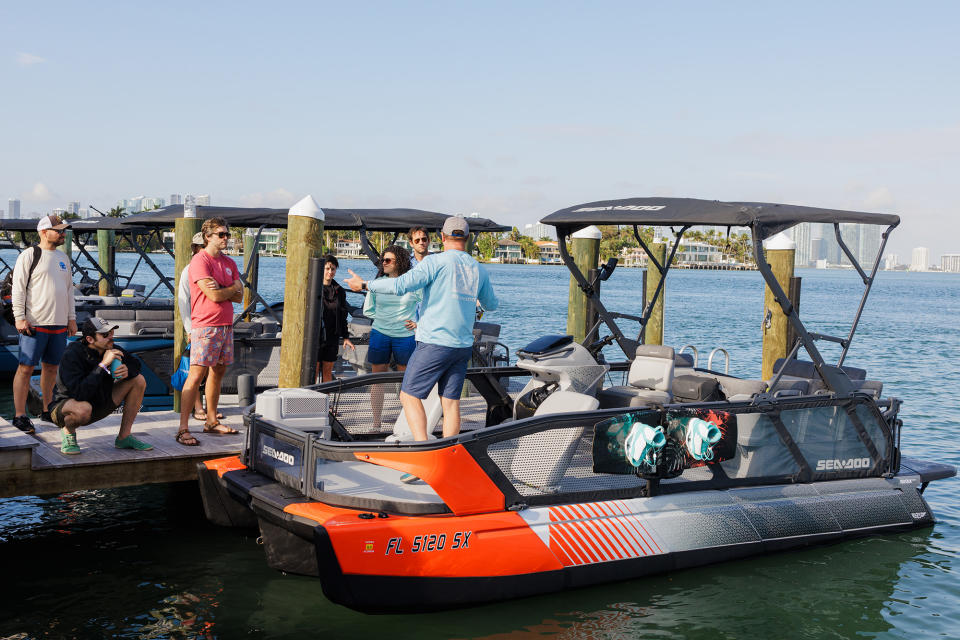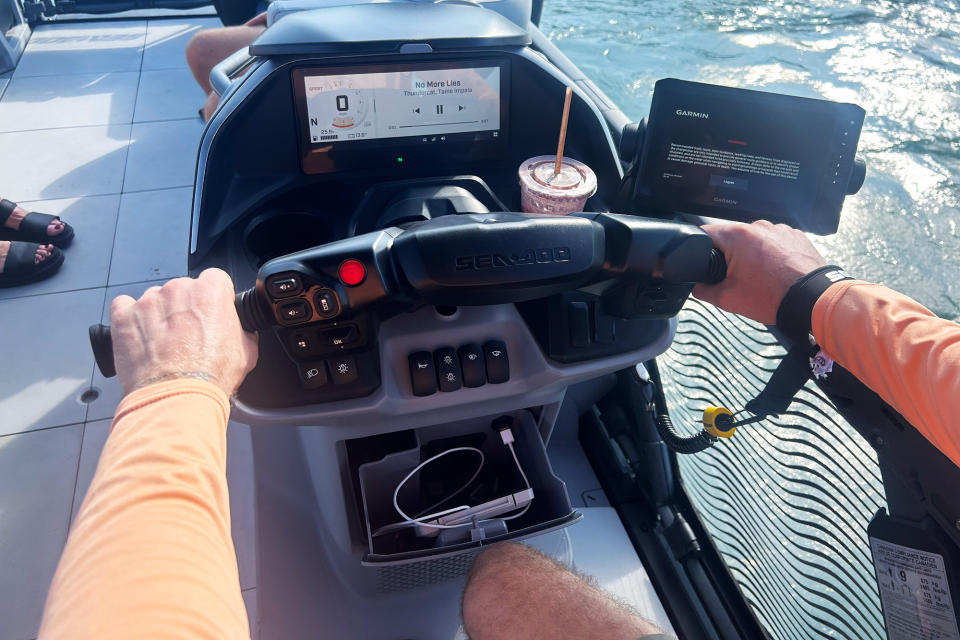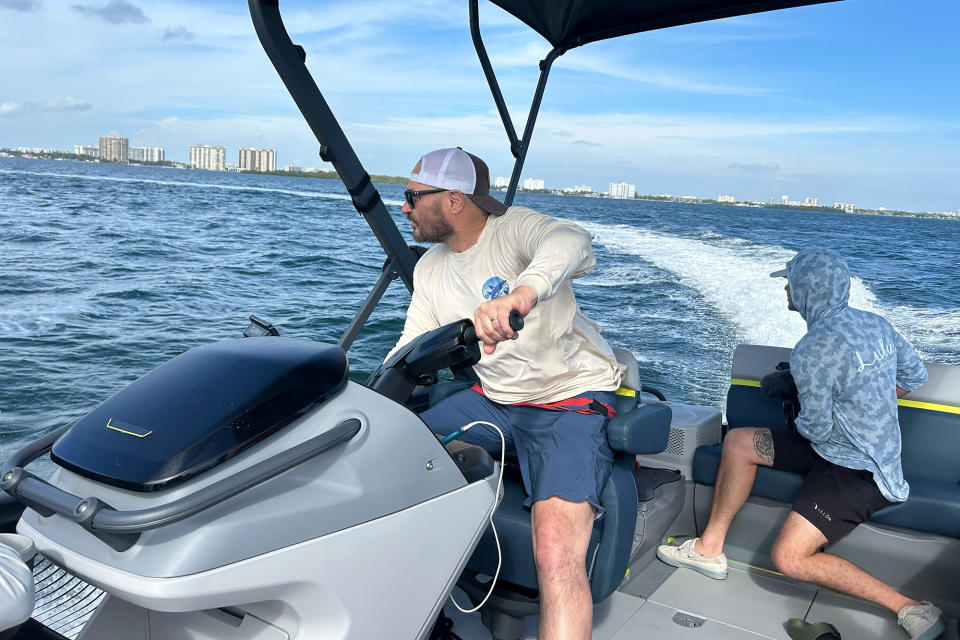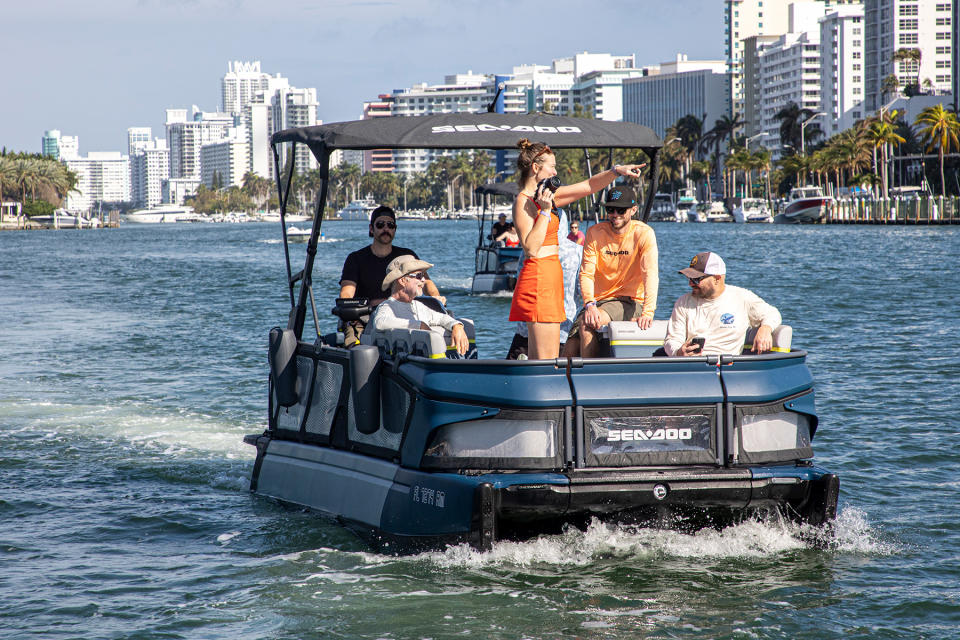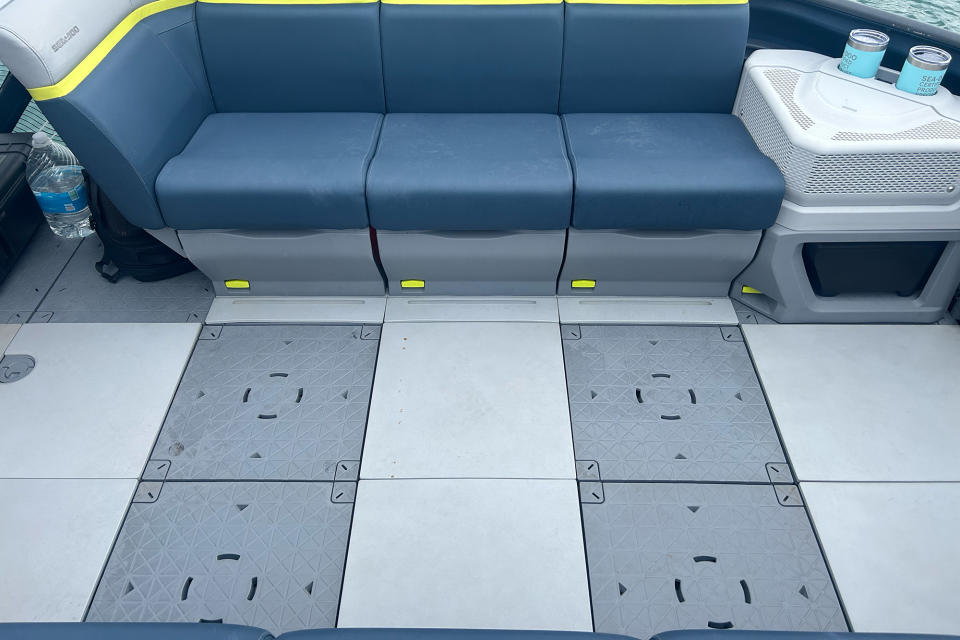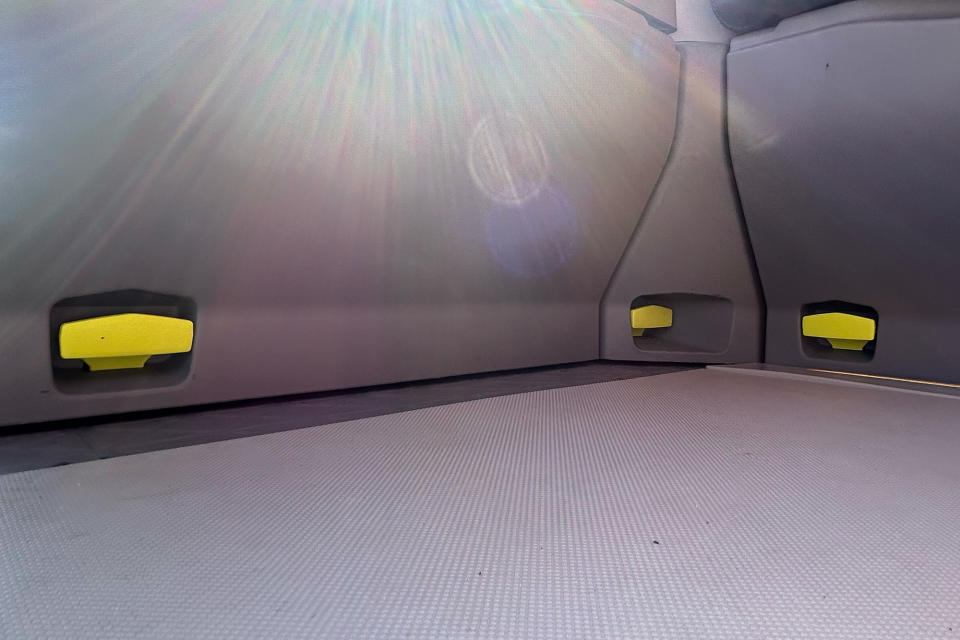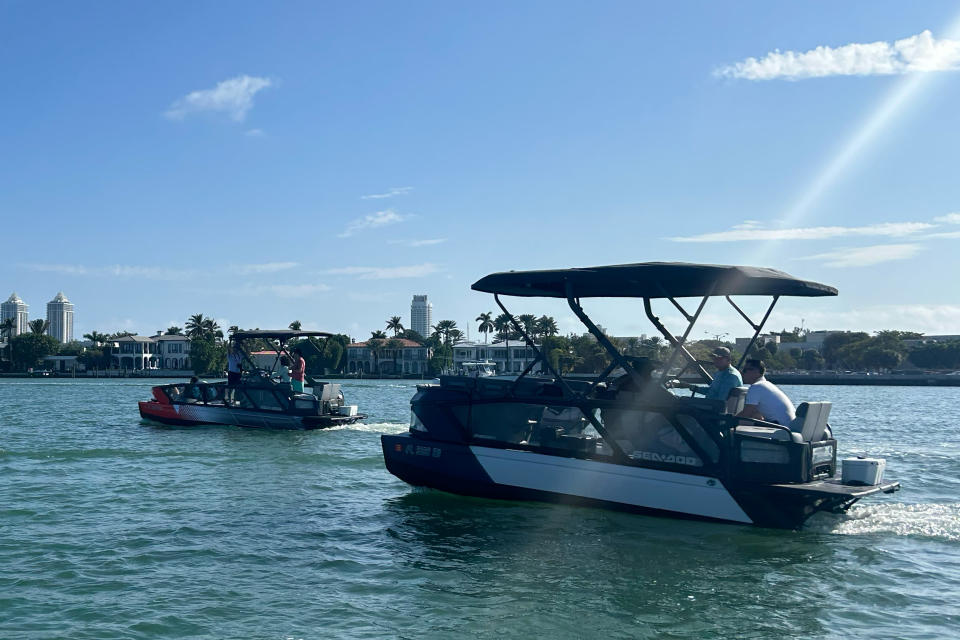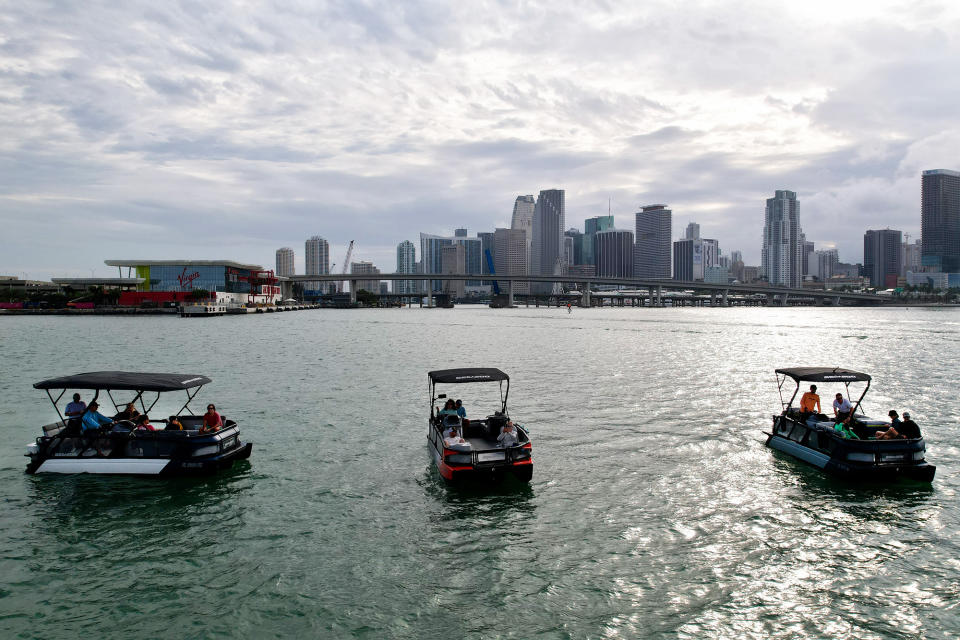Full Throttle Fun for First-Time Captains: Jet-Propelled Sea-Doo ‘Switch’ Pontoon Review
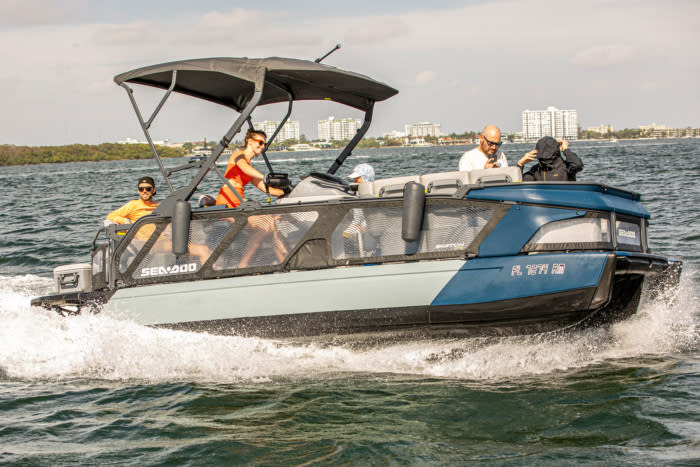
“Grip it and rip it!” My crew mates cheerfully egged me on after I cleared the last “No Wake Zone” and gingerly bobbed into the vast, open Atlantic Ocean. Ordinarily, a command like that would sound sarcastic on a pontoon. But they were very much serious — this was no ordinary pontoon, after all.
And up to now, my piloting skills were a little less Days of Thunder and a lot more Driving Miss Daisy. I’d only steered a pontoon a few times prior on Minnesota lakes, and that amounted to nothing more than steering a few degrees left or right out of boredom.
Everything was different now. Instead of the lapping shallows of Lake Vermilion, I stared into the rolling white caps of salty seawater — the Miami skyline just over my shoulder. And instead of a stout throttle shifter and classic steering wheel, I had both hands gripped on a yoke more akin to an ATV or PWC (personal watercraft).
It was all part of Sea-Doo’s plan. The Switch pontoon was specifically designed to add fun and reduce the anxiety and confusion of piloting a big boat — especially for first-timers. So with all eyes on me, I squeezed hard with my right hand and launched the 18-foot pontoon into the great blue horizon.
In short: If you’re new to boating and looking for an approachable, fun, user-friendly pontoon, the Switch was built for folks like you. Larger, more luxurious, and high-powered options abound, but perhaps none that spin on a dime and require no experience piloting an outboard motor. The controls are intuitive and simple, and the modular design allows you to grow and evolve your pontoon for a variety of occasions.
Sea-Doo Switch Review
If you think all pontoons look the same, you’re forgiven. I honestly felt the same when I agreed to try out a few iterations of the Switch lineup in Miami before spring. As a native Minnesotan, they’re as commonplace at cabin lakes as minivans in suburban driveways. And honestly, that’s how I thought of pontoons — like minivans for the water. They’re slow, comfortable, multi-passenger people-movers. (Maybe with a dash more party vibe.)
But the Sea-Doo folks promised the Switch was something different. So much so, in fact, the brand told me it expects the Switch — in just its third year on the market — to be the bestselling pontoon in North America! Based on the design of the Switch, the keys to that success are threefold: accessibility, modularity, and jet propulsion (yes, really).
Accessibility: All Aboard, First-Time Boaters!
I was admittedly nervous when I first sat in the captain’s chair of the Switch, even though, on paper, I was actually the ideal candidate since I’d never owned a pontoon and had limited experience.
The controls are arguably simpler and more intuitive. Sea-Doo gave the switch a handlebar helm akin to a dirt bike. A finger-actuated lever on the right handle controls the throttle, while an opposing lever on the left serves as a reverse propulsion brake and reverse.
Yes, Sea-Doo also touts the Switch as the first boat with brakes!
When navigating narrow lagoons in Miami with no-wake buoys, I have to say I liked the interface here. The steering felt a bit more responsive than past pontoons and boats I’ve steered. Steering-wheel pontoons with outboard motors have a “lake lag” that you have to adjust to. With the Switch, my steering inputs received swift and controlled response.
On the other hand, I think the traditional throttle lever is a tad easier when it comes to maintaining a constant speed. After all, whether cruising at max speed or navigating speed-controlled areas, you can set it and forget it. The Switch gives you a lot more instant control over the throttle, but like a gas pedal in a car, you have to moderate it in real time to maintain the speed you want.
To address this, Sea-Doo does have a cruise control button. It’s a small extra step, requiring a single button press with your left thumb.
But perhaps first-timers will appreciate the drive system itself more than the cockpit’s look and feel.
Jet Propulsion: Not as Scary as It Sounds
When I first heard that the Switch was “jet-propelled,” it did little to calm my newbie’s nerves. I envisioned skipping across the ocean surface, canted back at a 45-degree angle. But in reality, the Switch’s underwater jet is less about breakneck speed and more about overall simplicity.
In my opinion, this is Sea-Doo’s biggest design win. By endowing the Switch with propulsion akin to its PWCs, Sea-Doo does away with the iconic — and often intimidating — outboard motor. This gives the Switch a more singular, integrated look and feel and removes the concern over trimming the motor in shallows — and avoiding it when swimming around the pontoon.
The Switch also carries a “tri-hull” design. The main propulsion is housed under the center of the deck, but two outer pontoons are raised on either side. Unlike traditional pontoons, this allows the Switch to lean in turns, adding better handling and, frankly, more fun at higher speeds. Again, this feels similar to piloting a PWC.
Without getting too granular, the propulsion system has a couple of other benefits worth mentioning. First, if the impeller ever gets clogged (and it inevitably will), there’s a simple, push-button clearing feature. This is also helpful for basic maintenance, especially in salt water.
Second, the Switch has brakes and a very tight turn radius. You can turn the boat about-face quickly and almost in place — this is a super-handy feature for first-timers. Plus, the boat decelerates and stops well. It’s not dramatic, and you shouldn’t expect to lurch to a halt instantly. But the braking was effective, making piloting the boat under bridges and through tunnels with oncoming vessels much easier.
LinQ: One Boat, Any Way You Want It
When I first stepped aboard the Switch, I was greeted by two rows of cushioned seats at the front of the deck, both facing forward. It was a standard, unremarkable layout until one of the Sea-Doo team asked if I preferred “party mode.” Without waiting for an answer, he began pulling up square tiles from either side of the deck. These rubberized squares snap into and out of place as needed.
After he’d pulled up a handful, he reached under a few of the seats, pulled out a bright yellow tab, and then lifted the seats one by one. Below the seats and the tiles, in the deck itself, were identical cutouts — like four curved rectangles arranged in a circle.
He then snapped the seats where the tiles had been (and vice versa), giving the deck a whole new configuration. Now, two banks of seats lined either side of the deck. In all, the “switch” took no more than 3 minutes.
As you might guess, this is where the Switch gets its name. Virtually everything on the Switch is modular and meant to be configured (or removed) according to the customer’s preferences. Rearranging deck chairs is cool enough, but Sea-Doo leans hard into this feature.
Beyond seating, customers can purchase a wide array of “LinQ” accessories, all of which lock into the Switch deck: coolers, tables, outboard steps, and even Bluetooth speakers.
Everything carries the same yellow tab to lock and unlock the item into place. Not only is this consistent across any of Sea-Doo’s pontoons, but it’s also the same system on most of the parent company BRP’s lineup of PWCs, ATVs, and snowmobiles. This means there’s cross compatibility to add and swap accessories on some (not all) of these vehicles.
My trip had a limited variety of accessories, but for those who want to build out their pontoon, Sea-Doo has several pages of LinQ add-ons.
Sea-Doo Pontoon: From the Captain’s Chair
I had one full day driving three different models: The base Switch, the Switch Sport (for lead-foots), and the super-luxe Switch Cruise Limited. Sea-Doo offers four trims in total (base Switch, Sport, Cruise, and Cruise Limited) in lengths between 13 and 21 feet. Shorter boats are more nimble; bigger boats accommodate more passengers and have more room for accessories.
While the Sport had noticeably more thrust and is designed for maximum fun, all three offer very similar driving experiences, generally speaking. If your pontoon dreams have less speed and excitement, and more comfort and camaraderie, then the Limited model has a bit more to offer.
As a rookie captain, I had a little more thrill in the Sport — but only in open water. When I first “gripped it and ripped it,” I immediately began laughing. The Sport has delightful kick and, once you’re brave enough to really throw it into a turn, it offers a fair measure of excitement.
This is the boat to buy if you plan to water ski, wakeboard, or tow other thrill-seekers. It banks into high-speed turns and feels unlike any other pontoon I’ve been in. Other pontoons have power, but none handle quite like the Switch.
That said, for most of the driving I did, I preferred the Cruise Limited overall. I’m not an adrenaline junkie, and my idea of fun involves a cooler, tunes, relaxing, and when the time is right, jumping out of the boat and swimming.
For this, the Cruise Limited is like a limousine on the water. It was stable and fun even at low speed. It has a lot of bells and whistles — premium audio system, retractable sun shade, LED party lights, and seating for 10 passengers. Of course, this is the premium Switch offering, and the $50,999 price tag reflects it.
Conclusion: Should You Buy
Owning a boat has always seemed a little out of reach for me — mostly the price, but also the culture. I didn’t grow up with a boat, and it felt like when it came to captaining my own vessel, I quite literally “missed the boat.”
The Switch feels like a closer foothold into owning and operating a pontoon than had existed previously — at least in terms of feeling confident and capable at the helm. I didn’t have to adjust the trim to manage chop or enter “tow” mode to haul a waterskier behind me, but those features were at my fingertips and just a button push away.
There’s still a small education gap when it comes to maintaining a pontoon and keeping it in good working order, but Sea-Doo offers helpful articles and videos that can aid folks in knowing the full ins and outs of responsible ownership.
But as for having fun on water, the Switch is easy to pilot and highly customizable. So you’re not stuck with the same old pontoon you bought — you can modify and reconfigure the Switch to maintain the fun as your adventures evolve.
The tradeoff here is that the Switch doesn’t boast the kind of top-of-the-line luxury and finishing touches I’ve seen on high-end pontoons. And Lord knows the world of boats often caters to those with a taste for refinement. Plus, some folks will probably seek out the classic boating experience — up to and including outboard motors and a steering wheel.
As far as price, the Switch is by no means the most budget-friendly on the market. The entry-level base model starts at $23,699 and goes up to $50,999 (before any additional LinQ accessories). This means it’s very much in line with the market.
But if you’re pontoon-curious, enjoy rearranging your living room, and value fun over fashion, the Switch should definitely be a consideration when you’re ship shopping.
The post Full Throttle Fun for First-Time Captains: Jet-Propelled Sea-Doo ‘Switch’ Pontoon Review appeared first on GearJunkie.
